The Infalsificables: the last issue of the Constitutionalist government
by Cedrián López-BoschThe author would like to thank the help of Ricardo de León Tallavas, Luis Gómez Wulschner, Roman Guhr, Simon Prendergast, Siddharta Sánchez Murillo and Mark Tomasko in producing this article .
Starting from the second half of 1915, when the Constitutionalist movement seemed to emerge as the triumphant faction of the revolution, the Primer Jefe del Ejército (First Commander of the Army), Venustiano Carranza, decided to undertake the economic reorganization of the country, beginning by putting the circulation of money on a definitive basis. For this he suggested putting into circulation a new issue of notes to replace all the previous ones legitimately issued by his movement. With this he intended to unify the currency and define once and for all the exact amount of what he considered a sacred debt contracted by his movement with the Mexican people.
In order to guarantee its success this issue sought to address two shortcomings of its predecessors: to offer a guarantee in gold and to manufacture the notes in a paper of better quality and printed with plates engraved in steel, which would lead the same authorities to call them infalsificables (uncounterfeitable).
However, this effort was premature, fell short and failed to reestablish confidence in this method of payment because, as pointed out by Mónica Gómez and Luis Anaya“El Infalsificable y el fracaso de la establización monetaria en el Carrancismo, México 1916” in Intersticios Sociales, Num. 8, El Colegio de Jalisco, September 2014, the technical challenges, social pressures and economic shortcomings forestalled it. Although this resounding failure has been widely discussed, the following seeks to explain some lesser-known aspects of the preparation, circulation and withdrawal of this issue.
Antecedents and monetary problems at the end of the revolutionary movement
Between 1913 and 1915, paper money issues had grown exponentially. On the one hand, during Victoriano Huerta’s regime, the banks of issue, either through pressure or voluntarily, had increased the number of notes in circulation exceeding the limits established in the General Law of Credit Institutions of 1897, in force at that time. On the other hand, the different military factions had issued multiple kinds of paper currency such as notes, bonds and obligations to pay their troops and defray the administration expenses of the territories under their control, without any kind of backing. Finally, faced with the shortage of fractional currency, some individuals, businesses, firms and haciendas had put into circulation other means of payment such as vouchers and cardboard notes, with and without authorization from the political forces prevailing in each region.
To make this situation even more chaotic, as the revolution progressed and the territories passed from the control of some military leaders to others, there followed multiple decrees that declared one or other issue invalid and revalidated others to give them recognition in a specific region. In addition, the growing need for means of payment throughout the country and the shortage of machinery and supplies to produce them gave way to issues made on increasingly simple presses and with lower quality paper and ink, easily making them victims of counterfeiting. As Gresham’s Law Sir Thomas Gresham’s law (bad money drives out good) holds that when two currencies have legal tender the one composed of the more valuable metal will be hoarded and replaced by the one of less valuable metal, which will continue to circulate. supposes, this multiplicity of paper currency, without any backing, caused the hoarding or export of gold and silver coins, making them disappear from circulation.
With the Provisional Government issue, issued in Mexico and Veracruz, Authorized by a decree of 19 September 1914. The Mexico issues are dated 28 September and 20 October 1914 and the Veracruz issues 1 December 1914 and 5 February 1915 Carranza had expressed his intention to achieve uniformity in the means of payment and to allow holders to distinguish notes that had legal tender from those that did not, by exchanging the notes issued earlier for them. However, in the country a myriad of authentic and false issues circulated, as previously described, including counterfeits and reproductions of those same issues of the Provisional Government, some of them printed with the original lithographic plates left in Mexico City when the Carrancista troops moved the capital to Veracruz Although known references to these issues point to impressions made in the state of Morelos (vide Elmer Powell ‘’The Provisional Government of Mexico issues (Mexico and Veracruz)” in USMexNA Journal, March 2014), in October 1915 the Constitutionalist consul in San Francisco, Ramón P. De Negri wrote to Venustiano Carranza asking about a possible theft of plates, due to the presence in that city of an individual with a Spanish passport named Cecilio Herero, with instructions from Hipólito Villa to make impressions to put into circulation in the territories occupied by Villista troops (CEHM, Fondo XXl-4 Archive of Venustiano Carranza, telegram of De Negri to Carranza, 21 October 1915). Surely there were multiple counterfeits as there were multiple legitimate printings of these notes..
However, the disorder was not only outside, but also within the Constitutionalist movement itself. Besides anecdotes of abuses by officials of the Treasury or Revenue offices who were in charge of exchanging or revalidating issues, a report sent on 15 June 1915 by Álvaro Pruneda described an absolute disorganization and discontent in the same Treasury Printing Office and serious deficiencies in the Verification Department of the Treasury in charge of identifying counterfeits Summary presented to Carranza (CEHM, Fondo XXI Archive of Venustiano Carranza, 43.4641.1-2). A more complete version must have been presented to the Minister of Finance, Luis Cabrera.. This study, in addition to the administrative measures necessary to improve the efficiency and control of both offices, recommended implementing a series of advanced measures against counterfeiting, particularly striking in the armed context, through the preparation of:
III ... a new issue of paper currency, as if it were from a State Bank, with the following defenses against all forgery:
a) Paper of special manufacture with a watermark and a combination of silk threads in the pulp
b) The inks used must have special reagents in their preparation
c) The engraving should be the most original and protected by technical difficulties
d) Invisible security marks so that photographs cannot be taken and which can only be discovered by a special procedure
e) A combination of progressive or logarithmic numbering
f) A special register of circulation.
IV. For this issue, to produces notes of only $5, $10, $50 and $100, carefully printed on a press directly from steel sheetsidem..
To bring about this situation and solve the problem of counterfeiting, on 21 July 1915, Carranza issued a new decree which authorized the issue of 250 million pesos in banknotes. With this amount he intended to replace all the notes in circulation issued by the Constitutionalist Government and his military commanders with others, following the suggestion of Pruneda, “of an artistic perfection such that its falsification was not possible” and “to meet the needs of the government, thanks to the increase in the national debt”. The denominations of this issue were to be 5, 10, 20, 50 and 100 pesos, and all of them would have the signatures of the General Treasurer, Nicéforo Zambrano and Rafael Nieto, Undersecretary in charge of the Treasury Secretariat, the office responsible for fixing the series, numbers, marks and countermarks, as established by the decree.
A few days later, in an interview for the official newspaper El Pueblo, Undersecretary Nieto described this issue as a “true artistic novelty. [Because] neither the Government, nor any of the issuing banks in Mexico, had printed notes of such fine quality as those of the new issue that is being prepared," and added:
“The new notes will be printed by the most prestigious American firm dealing in this matter, and the best materials that exist will be used in them. The paper to be used is cellulose on a thread base, with a special watermark. The finest inks and the least common colors will be used.
The engravings, designs, security marks, edges and borders will be entirely original, having on the faces multi-colored geometric engravings, very novel and artistic, as an absolute proof against counterfeiting.
The reverses will probably contain the beautiful and severe Aztec calendar. The faces will show carefully chosen designs: the Faros building, the monuments to Juárez and Cuauhtémoc in Mexico City, and others.
For the general ornamentation, borders, edges, etc. the ruins of Uxmal have provided exquisite ideas”“Los billetes de la Nueva Emisión. El Señor Sub-Secretario de Hacienda da detalles acerca de su factura”, El Pueblo, 25 July 1915; El Dictamen, Veracruz, Tomo XVII, Num 1564, 25 July 1915.
Surely, to give these details, the negotiations with the chosen American printing house, which could not be other than the American Bank Note Company (“ABNC”), should have been well advanced and probably had already seen some models. How would that have been possible? In his memoirs, former President Pascual Ortiz Rubio tells that he was commissioned to direct and monitor the printing of these notes Pascual Ortiz Rubio, Memorias (1895-1928), México, Academia Mexicana de Historia y Geografía, serie Divulgación Cultural Vol. 3., p 54., He already had some experience in the matter: in 1914 he had worked under the orders of Alberto J. Pani in the Stamp Printing Office as responsible for applying seals to the Constitutionalist notes in Ciudad Juárez, and when the capital of the Provisional Government was installed in Veracruz, at the end of that year, he had taken over the transfer of the presses and matrices of the Printing Office of the Government in Mexico City to that state, being responsible for establishing and directing a Note Printing Office in the port.
At the beginning of February 1915, the Secretary of the Treasury, Luis Cabrera, sent him to manage the printing of Constitutionalist notes in the United States. Ortiz Rubio arrived in Washington and from there moved to New York where he met with three printers specializing in engraving paper money, the ABNC, the New York Bank Note Company (successor to the Kendall Bank Note Company, which had already produced some issues for Mexico) and the Hamilton Bank Note Company, as well as three paper mills, National Paper, Grane (sic) Obviously a reference to Crane, the company that provided paper for US banknotes and Parsons. As reported to Carranza, the companies that responded best to Secretary Cabrera’s instructions regarding delivery time, quantity and price were the New York Bank Note Company and Parsons. “ Report of lng. Pascual Ortiz Rubio, to Venustiano Carranza, of the result of the commission conferred by Luis Cabrera to manage the printing of Constitutionalist notes, in the city of New York", in Isidro Fabela (comp.), Documentos Históricos de la Revolución Mexicana XVI, Revolución y Régimen Constitucionalista, Tomo 1, Volumen 4, Comisión de Investigaciones Históricas de la Revolución Mexicana, Editorial Jus, México, 1969, pp.101-104. Taking advantage of his relationship with lithographic printers, Ortiz Rubio immediately signed a contract with the latter for the printing of one and two peso notesABarragán, Caja 3.3 exp. 24 (2), that is, not the infalsificable but still the Veracruz issue, to meet the demand for low denomination currency to pay the troops and sustain commercial activities in most of the territory controlled by the Constitutionalists, given the inability of the Printing Office in Veracruz to supply them. I have not located any more details of the activities carried out by Ortiz Rubio in the United States, but he would have received instructions to remain there to support Colonel Alfredo Breceda CEHM, Fondo XX l-4 telegrams of Carranza to Pascual Ortiz Rubio and Alfredo Breceda, 29 May and 11 June 1915, respectively, a man of Carranza’s highest confidence, and he would have ended up selecting the ABNC to perform, at this time, the printing of the infalsificable notes, negotiating the contractConfer CEHM, Fondo XXl-4 Telegrams of Luis Cabrera to Carranza, 18 and 23 August 1915 (vide infra), approving the designs and supervising the works. For personal reasons –the illness and death of his mother - Ortiz Rubio left this task to Jorge U. Orozco, and then, according to his account, to the consul and financial agent in New York, Dr. Alfredo Carturegli. CEHM, Fondo XXl-4, Telegram of Carranza to Luis Cabrera, 25 February 1916: 17. CEHM, Fondo XXI, 69, 7570 1; 18. Another character also involved was Luis Montes de Oca, who would be appointed Secretary of the Treasury a little more than a decade later, although I have not yet been able to identify his role in this company..
Planning the issue
Parallel to the design and printing, it was necessary to plan the introduction and adjust it to the delivery times. In mid-October 1915, Undersecretary Nieto informed Carranza of a delay in the delivery of the notes until the end of December, as reported by Ortiz Rubio and Carturegli, disrupting plans to announce an increase in the total national debt contracted with this new issue CEHM, Fondo XXl-4 Telegrams of Rafael Nieto to Carranza, 16 and 19 October 1915. Nieto rejected Carturegli’s suggestion to print lithographed notes, but he was considering the possibility of printing another 250 million “with another credit house (sic) similar to the American Bank Note Company even if it had the disadvantage that the issues from both houses were not exactly the same” CEHM, Fondo XXl-4 Telegram of Rafael Nieto to Carranza, 19 October 1915. Carranza responded by accepting the suggestion, ”taking care to notice that the engravings (sic) of the notes are different to the model that the American Bank Note [Company] has made” CEHM, Fondo XXl-4 Telegram unsigned to Rafael Nieto, 24 October 1915. The resolution of this matter, as indicated in Carranza’s telegrams, must have been a meeting between both officials, so the reason for not printing them in another printing house is unknown.
With the passage of the months the expenses of the Constitutionalist movement increased. Perhaps the delay in putting this issue into circulation justified, in part, the increasing amounts of Provisional Government notes in Veracruz that far exceeded the authorized amount. This made it necessary, as Undersecretary Nieto had anticipated months before, to increase the total amount of the debt again. To this end, on 25 February 1916, Carranza instructed the Ministry of Finance and Public Credit to take the necessary measures to fix and raise the value of the currency of the Constitutionalist Government; recognizing and defining the total amount of the debt contracted with the Mexican people; creating a guarantee fund; ensuring autonomy in the management of finances; preserving the interests of the people over those of banking, industry and commerce and looking for ways to prevent counterfeiting Venustiano Carranza, 25 February 1916, in Manero, La Reforma Bancaria en la Revolución Constitucionalista, México, 1958, INEHRM., pp 206-209.. So, on 3 April 1916, Carranza issued another decree in Querétaro setting at 500 million the amount of public debt, in the form of fiduciary currency, and instructing the said Ministry to put it into circulation as of 1 May. Similar to the July decree of the previous year, he pointed out that they should be printed on special paper as infalsificable. The following table details the amount of notes and face value of both decrees:
| Table 1: Constitutionalist decrees referring to the issues of the infalsificables | ||||
| 21 July 1915 | 3 April 1916 | |||
| Denomination (pesos) | Quantity | Total value (pesos) | Quantity | Total value (pesos) |
| 1 | 50,000,000 | 50,000,000 | ||
| 2 | 25,000,000 | 50,000,000 | ||
| 5 | 10,000,000 | 50,000,000 | 10,000,000 | 50,000,000 |
| 10 | 5,000,000 | 50,000,000 | 5,000,000 | 50,000,000 |
| 20 | 2,500,000 | 50,000,000 | 5,000,000 | 100,000,000 |
| 50 | 1,000,000 | 50,000,000 | 2,000,000 | 100,000,000 |
| 100 | 500,000 | 50,000,000 | 1,000,000 | 100,000,000 |
| Total | 19,000,000 | 250,000,000 | 98,000,000 | 500,000,000 |
That new decree doubled the authorized amount authorized on 21 July 1915 and included one and two pesos denominations but did not give more characteristics. To put them into circulation, on 4 and 5 April, Carranza created a Monetary Commission, empowered to “collect, conserve and administer the funds designated by the Government to regularize and guarantee internal circulation within the country and to serve as a conduit for the issue and withdrawal of currency issues” and a Regulatory Fund to guarantee the circulation of this currency.
On the 28th of that same month Carranza issued two new decrees; one to indicate the issues to be withdrawn and the terms on which they would be withdrawn, and another to launch this infalsificable issue into circulation, with a backing in national gold of 20 centavos per peso. Unlike previous issues, they would not exchange old notes for new, but, instead, the infalsificable currency, in seven denominations (1, 2, 5, 10, 20, 50 and 100 pesos), would enter circulation through all payments made by the federal and local governments -including salaries- and the old paper currency (the Ejército Constitucionalista and Veracruz issues) would continue to circulate without limit and would be decommissioned when paid in to public offices, either for taxes or services. Another twenty issues made by the main military and civilian leaders, recognized by the Constitutionalist movement, were to be deposited in the Ministry of Finance, Treasury and Revenue offices for their subsequent exchange. The 20, 50 and 100 peso notes of Veracruz would stop circulating on 6 June, although they could be deposited in these offices during the months of June and July in exchange for national gold certificates, again for their subsequent exchange, and those of 1, 5 and 10 pesos would be valid for private transactions until 30 June, although they would be received in payment of taxes until the end of 1916.
Although the seven denominations of one to one hundred pesos are part of the same issue, it seems that they are of two completely different sets, since they were made by different factories, with different printing processes and based on different decrees. The $5 to $100 notes were printed in New York by the ABNC with plates engraved in steel, bear the title of “ República Mexicana - Gobierno Constitucionalista “, lack a date and were issued based on the decree of 21 July 1915. The two lesser denominations were produced in the Government Printing Office of Mexico, bear the same title of the previous issues, that is, “Gobierno Provisional de México”, are dated 1 May 1916 and were put into circulation as the result of a decree of 3 April 1916. All were signed by the Treasurer General, Nicéforo Zambrano and the Undersecretary of Finance, Rafael Nieto.
|
He was Nuevo León’s deputy to the Constituent Congress at Querétaro and when Carranza was elected President, he became Tesorero General de la Nación. He served as governor of Nuevo León from 1 July 1917 to 4 October 1919. On Carranza’s fall he retired to private life and died in Monterrey on 20 September 1940, at the age of 82 |
 |
|
He died in Sierre, Switzerland, on 11 April 1926. |
Although in the numismatic field only those of the ABNC are known as infalsificable, as all were put to circulation as part of the same issue and the Carrancista government referred to both types as infalsificable currency, I will consider it so in this article.
Infalsificables printed by the ABNC
On 21 July 1915 Carranza sent a letter to Secretary Cabrera authorizing him to arrange the printing of the notes in the United States. The contract was prepared as of August While in New York, Minister Cabrera reported to Carranza: “We start work on the new issue as soon as I receive money to sign a FOVO contract, I ask Nieto for one hundred thousand, I hope to leave hospital next week, but from here I will attend to the issue of notes.” CEHM, Fondo XXl-4, telegram of Luis Cabrera to Carranza, 18 August 1915. and signed on 15 September by Secretary Cabrera and Messrs. Daniel E. Woodhull, First Vice-President of ABNC and Albert S. Shomp, Assistant Secretary. For a total amount of $24,200 U.S. it included the engraving of the matrices, rollers, plates and seals and the printing of 19 million notes of five denominationsNumismatic Collection of the Banco de México, #444. Following ABNC records, these were presented or approved in October of that year.
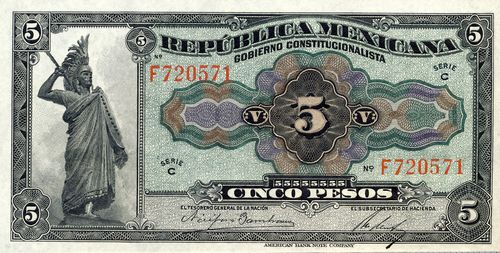
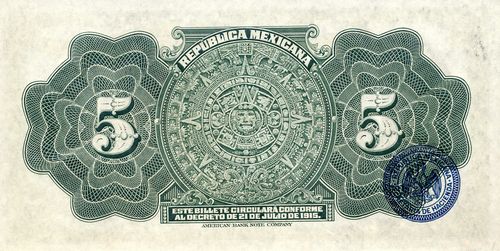
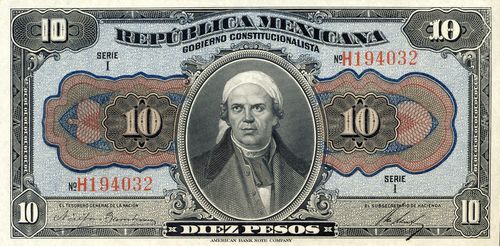
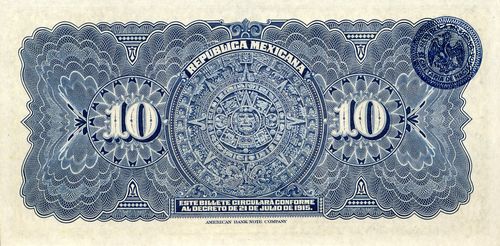
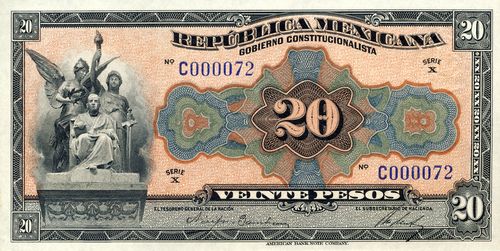
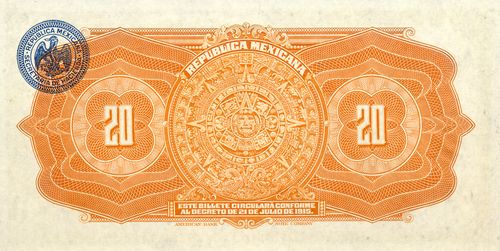
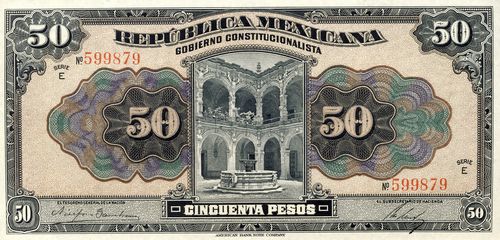
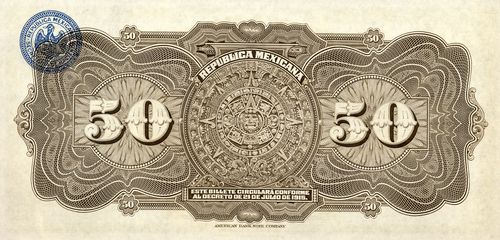
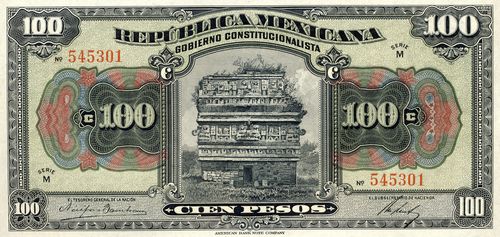
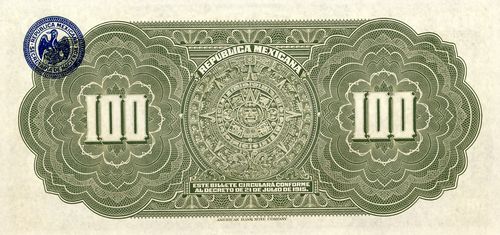
The five denominations printed by this company were made with steel plates, are in four different sizes (the $5 2⅝ by 5½ inches; the $10, 3 by 5½ inches; the $20 3 by 6⅛ inches, and the $50 and $100 3⅜ by 7 inches), and with vignettes engraved with a burin or by etching, specific for each denomination on the face and with a common reverse. The five pesos were printed in 15 notes per sheet, the 10 and 20 pesos, and the 50 and 100 pesos in 12 and 8 subject sheets, respectively.
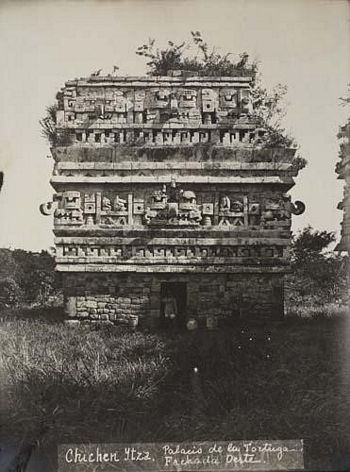 On the face of the $5 note appears a vignette engraved by Charles Skinner of the monument to Cuauhtémoc, designed by Francisco M. Jiménez in 1887 and located on the current Paseo de la Reforma in Mexico City. This vignette was commissioned in 1899 especially for the reverse of the one and two peso certificates of deposit of the Banco Internacional Hipotecario de México and was classified as C-376 in the ABNC fileThanks to Mark Tomasko for his help in identifying the numbers and engravers of the vignettes.. The same monument, but from a different angle, adorns the $1,000 note of the Banco Occidental de México. The other denominations have special vignettes created in 1915. A bust of Generalissimo José María Morelos, engraved by Robert Savage, illustrates the ten pesos note (C -423) At this time, the portraits had a different numeration to the vignettes, although they also began with the letter C. The twenty pesos show the seated statue of former president Benito Juárez, franked by two allegorical figures representing Patria and justice, engraved by William Adolph (C-1458). The statue is similar to the one made by the Italian sculptor Lanzaroni for the hemicycle to this hero built in 1910 and located in the Alameda Central of the capital. An engraving made by William J. Brown of the baroque style cloister of the ex-convent of San Agustín in Querétaro (C-1459), built in the 18th century, which served as a barracks, hospital, Government Palace and is currently the headquarters of the Art Museum of that city, is illustrated on the fifty pesos. This was re-engraved by Harold Osborn in the middle of the thirties for the reverse side of the $20 note of the Banco de Mexico (V-76830). Finally, the $100 note has an engraving by Edwin Gunn of a Mayan building located in Chichen ltza, a mixture of Puuc and Chenes styles, known as “la iglesia (the church)” (C-1455), although it appears as “the west façade of the Palacio de the Turtle” in a photograph from the time of Charles B. Waite, which could have been used as a model for this engraving.
On the face of the $5 note appears a vignette engraved by Charles Skinner of the monument to Cuauhtémoc, designed by Francisco M. Jiménez in 1887 and located on the current Paseo de la Reforma in Mexico City. This vignette was commissioned in 1899 especially for the reverse of the one and two peso certificates of deposit of the Banco Internacional Hipotecario de México and was classified as C-376 in the ABNC fileThanks to Mark Tomasko for his help in identifying the numbers and engravers of the vignettes.. The same monument, but from a different angle, adorns the $1,000 note of the Banco Occidental de México. The other denominations have special vignettes created in 1915. A bust of Generalissimo José María Morelos, engraved by Robert Savage, illustrates the ten pesos note (C -423) At this time, the portraits had a different numeration to the vignettes, although they also began with the letter C. The twenty pesos show the seated statue of former president Benito Juárez, franked by two allegorical figures representing Patria and justice, engraved by William Adolph (C-1458). The statue is similar to the one made by the Italian sculptor Lanzaroni for the hemicycle to this hero built in 1910 and located in the Alameda Central of the capital. An engraving made by William J. Brown of the baroque style cloister of the ex-convent of San Agustín in Querétaro (C-1459), built in the 18th century, which served as a barracks, hospital, Government Palace and is currently the headquarters of the Art Museum of that city, is illustrated on the fifty pesos. This was re-engraved by Harold Osborn in the middle of the thirties for the reverse side of the $20 note of the Banco de Mexico (V-76830). Finally, the $100 note has an engraving by Edwin Gunn of a Mayan building located in Chichen ltza, a mixture of Puuc and Chenes styles, known as “la iglesia (the church)” (C-1455), although it appears as “the west façade of the Palacio de the Turtle” in a photograph from the time of Charles B. Waite, which could have been used as a model for this engraving.
Some of these themes had been anticipated by Undersecretary Nieto in the interview given to El Pueblo (vide supra). Nieto probably already knew the designs. One notices the absence of the Faros building in Veracruz, headquarters of the Provisional Government and residence of Carranza while the capital was established in that port, and the appearance of the Federal Palace in Querétaro, where the First Chief had his office months later and during the Constituent Assembly.
To futher hinder counterfeiting they all have backgrounds in various colors printed in geometric patterns (imaginatively called “machina loca” in the contract in Spanish), microprinted texts with “Constitución y Reformas”, the motto of the Carrancista movement, different rosettes and the denomination in different fonts and sizes in the four corners. The serial number is printed twice on all denominations in red, except on the 20 pesos where it is in blue to improve the contrast with the background. Unlike the notes printed in Mexico these do not have a date of issue.
On the back, all are printed in intaglio in a single color, with the respective denomination and a vignette in the center of the Piedra del Sol or Aztec Calendar (C-759), engraved in 1900 especially for the $500 banknote of the Banco Occidental de México by Edwin H. Gunn and Charles Skinner. This had been proposed for the reverse of the unissued 50c notes of the Banco Oriental de México in 1914, of the Banco de la República Mexicana in 1918, and finally used in these infalsificables and in the very famous one peso banknote of the Banco de México between 1935 and 1970.
On the reverse, they also have the seal of the Ministry of Finance. Although normally these seals were applied in Mexico and the newspaper El Pueblo indicated that the notes would be sealed and counterstamped by the Stamp Printing Office“El día 12 del mes entrante estarán ya resellados y contraseñados los billetes de la nueva emisión”, El Pueblo, 1 April 1916, just as those of the banks of issue, the text of the contract and the appearance of specimens with this characteristic, prove that they were requested and delivered completely finished from New York and perhaps this was due to the presence of a Carrancista representative, such as Ortiz Rubio, during the printing process. All the notes have the traditional imprint with the name of the company on the front and back.
| Table 2: ABNC Print runs of Infalsificablesbased on Magan, Latin American Bank Note Records and the contract between Luis Cabrera and the ABNC in Numismatic Collection of the Banco de México, Varios Nacional #444 | ||||||
| Date of print | Denomination (pesos) | Quantity | Price per thousand (dollars) | Numbers | Series (prefixes) |
|
| from | to | |||||
| October 1915 | 5 | 10,000,000 | 11.35 | 000001 | 1000000 | C (without prefix and A-J) |
| 10 | 5,000,000 | 12.50 | 000001 | 1000000 | I (without prefix and A-D) | |
| 20 | 2,500,000 | 12.35 | 000001 | 1000000 | X (without prefix and A) | |
| 000001 | 500000 | X (B) | ||||
| 50 | 1,000,000 | 14.15 | 000001 | 1000000 | E | |
| 100 | 500,000 | 15.35 | 000001 | 500000 | M | |
| April 1916 | 20 | 1,000,000 | 500001 | 1000000 | X (B) | |
| 000001 | 500000 | X (C) | ||||
| 50 | 300,000 | 000001 | 300000 | E (A) | ||
| 100 | 150,000 | 500001 | 650000 | M | ||
| May 1916 | 5 | 5,000,000 | 000001 | 1000000 | C (K-P) | |
| 10 | 2,500,000 | 000001 | 1000000 | I (E-F) | ||
| 000001 | 500000 | I (G) | ||||
| August 1916 | 5 | 10,000,000 | 000001 | 1000000 | C (Q-Z) | |
| 10 | 5,000,000 | 500001 | 1000000 | I (G) | ||
| 000001 | 1000000 | I (H-L) | ||||
| 000001 | 500000 | I (M) | ||||
According to the records of the ABNC, a total of just under 43 million notes were printed in four orders. That of October 1915, covered by the original contract, was for the total amount of the previous July decree, i.e. 250 million pesos, and three more throughout 1916 added a face value of 450 million pesos (table 2). The second order was originally larger, but ABNC delivered fewer notes. In the minute book of the Monetary Commission, two payments for 27,600 and 26,348 .75 U.S. dollars to the ABNC are mentioned, in April and May 1916 for 50% of the value of a new contractAGN, SC226 Comisión Monetaria, Caja 69, Libro de Actas No.1 of the Comisión Monetaria, Acta #13. 20 May 1916, p16.
The notes were delivered F.O.B. in New York. The first remittances were reported to Carranza by Undersecretary Nieto and the commercial agent in New York, Francisco Elias, in December 1915. he first reported the dispatch of 650,000 notes on the steamer “Esperanza”, and the second 17 cases on the steamer “Monterrey”, both to Veracruz. CEHM, Fondo XXl-4, telegrams of 20 and 30 December 1915 respectively.. According to the same Undersecretary, the notes would have been delivered to the commissioner José Cuevas Gutiérrez, who was then manager of the Commercial Exporting Agency in Veracruz, who would keep them in a safe place while the issue was madeCEHM, Fondo XXl-4, telegram of Rafael Nieto to Carranza, 20 January 1916. In March, these notes would be transferred from Veracruz to the Federal DistrictCEHM, Fondo XXl-4, telegram of Carranza to Rafael Nieto, 16 March 1916 and, on the point of entering circulation, the arrival of more notes printed by the ABNC was reported in Veracruz Periódico Oficial del Estado de Chihuahua, 8 April 1916, Sección telegráfica, p. 7. These could still be part of the first order or even include the second print order.
Infalsificables of the Oficina (Impresora) del Gobierno - México
As mentioned earlier, as the Constitutionalist movement consolidated its power, it increased the needs for resources, as well as fractional currency, to pay the troops and settle daily commercial transactions. Therefore, the decree of 3 April 1916 not only doubled the amount of the issue but included the denominations of one and two pesos, omitted in July 1915.
Considering that Carranza’s government intended to print the notes in Mexico, shortly after the issue of this second decree, the Chief of Engraving of the Stamp Printing Office, Fernando Fernández, was instructed to acquire a printing machine from the United States“Será adquirida una máquina notable para imprimir billetes”, El Pueblo, 20 April 1916. However, this cannot have been the machine used in this issue, because several later newspaper articles report its arrival was still expected; one article said that it was similar to the presses of the ABNC, “Los billetes del Banco Único serán hechos en México”, El Pueblo, 25 August 1917 another that it came from the Bureau of Engraving and Printing“Llegó a Laredo magnifica maquinaria para la impresión de billetes, siendo idéntica a la que posee la American Bank Note Ca. de Nueva York”, El Pueblo, 25 August 1917; “Llegó la maquinaria adquirida por el gobierno”, El Pueblo, 27 October 1917; “Las imprentas del gobierno quedarán instaladas en Palacio Nacional”, El Pueblo,18 January 1918, “lnstalación de maquinaria moderna”, El Informador, 4 January 1918.
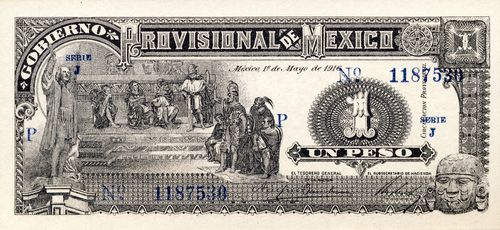

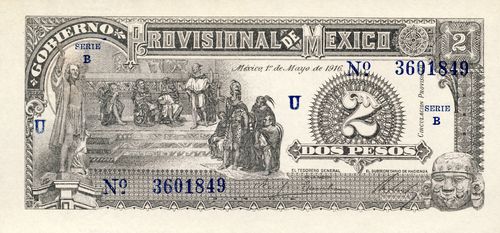
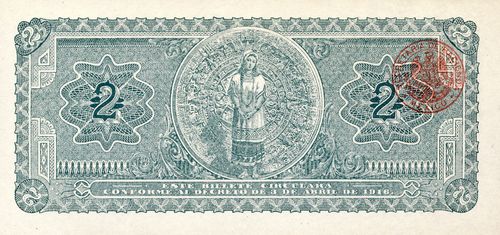
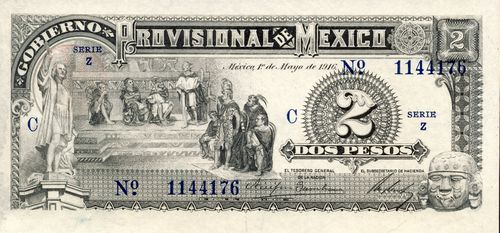
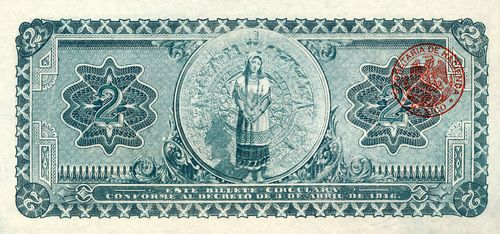
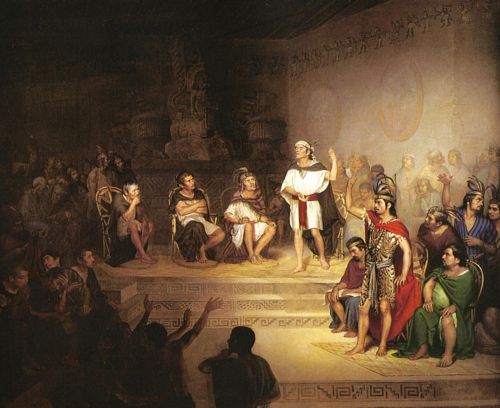 On the face, the one and two pesos notes show on the left a reproduction of the Monument to Christopher Columbus by Charles Cordier, erected in 1877 in the Paseo de la Reforma in Mexico City; at the center, as reported by the newspaper El Pueblo, “an engraving of the Tlaxcala Congress at the time when the situation of that republic (sic) was being debated when the conquistadors led by Hernán Cortés invaded America; “Se están Imprimiendo ya los billetes de a $1.00 y $2.00, de la nueva emisión”, El Pueblo, 4 March 1916 a replica of an 1875 oil painting by Rodrigo Gutiérrez, who participated in the Universal Exhibition of Paris in 1889, and which is now in the National Museum of Art, and in the lower right corner a sculpture of the head of the Aztec goddess of the moon, Coyolxauhqui, found in 1830 in the excavations of the old convent of La Concepción, part of the Templo Mayor, taken at the beginning of the 20th century to the National Museum and exhibited today in the National Museum of Anthropology and History. The reverse, according to a contemporary article, “represents the Aztec Calendar, in front of which is the Malintzi[n]” idem. franked by two rosettes with the denomination.
On the face, the one and two pesos notes show on the left a reproduction of the Monument to Christopher Columbus by Charles Cordier, erected in 1877 in the Paseo de la Reforma in Mexico City; at the center, as reported by the newspaper El Pueblo, “an engraving of the Tlaxcala Congress at the time when the situation of that republic (sic) was being debated when the conquistadors led by Hernán Cortés invaded America; “Se están Imprimiendo ya los billetes de a $1.00 y $2.00, de la nueva emisión”, El Pueblo, 4 March 1916 a replica of an 1875 oil painting by Rodrigo Gutiérrez, who participated in the Universal Exhibition of Paris in 1889, and which is now in the National Museum of Art, and in the lower right corner a sculpture of the head of the Aztec goddess of the moon, Coyolxauhqui, found in 1830 in the excavations of the old convent of La Concepción, part of the Templo Mayor, taken at the beginning of the 20th century to the National Museum and exhibited today in the National Museum of Anthropology and History. The reverse, according to a contemporary article, “represents the Aztec Calendar, in front of which is the Malintzi[n]” idem. franked by two rosettes with the denomination.
There are three notes with this design, one of one peso and two of two pesos, all of them with the imprint on the face “ Oficina del Gobierno - México “. One of each denomination was printed by lithographic process, with the legend “circulación provisional”. The ones of one peso show the series J, and those of two pesos the series A and B. The two pesos was replaced by another similar one, theoretically printed with plates engraved in steel, although the differences are not very remarkable, without the said legend and with the Z series. The faces are printed in black - although some of two pesos are brown - with numbers and series in blue, while the reverse of those of one peso is coffee with a seal of the Ministry of Finance in blue, and of two pesos are green with a red seal. In addition to color and denomination, another difference between both notes is in the backgrounds; The one peso have small squares with a “1”, franked by this same figure in the four cardinal points and the word “UNO” horizontally and “Mexico” vertically. Those of two pesos have smaller microprinted texts with the word and the number “2”
The El Pueblo article attributed the design and engraving to Fernando Fernández and mentioned an additional denomination in preparation, 50 centavos, unknown until now. The Patrimonial Collection of the Stamp and Seal Printing Workshop has a model of this denomination.
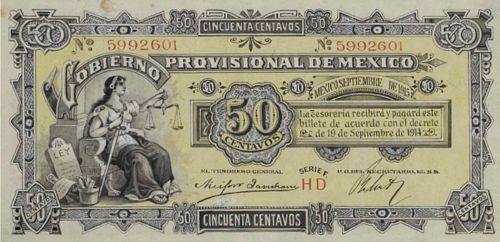
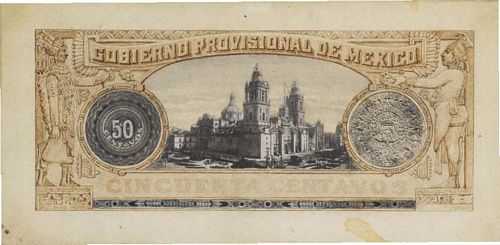
Although the reference to the decree of 19 September 1914 suggests that this model had been prepared to complete the issue of the Provisional Government of Mexico (or Veracruz), the date September 1915 seems to indicate that it was intended to be used at a later date, possibly when the next issue was prepared. The three denominations should have been presented by the Undersecretary Nieto to Carranza CEHM, fondo XXl-4, telegram of Rafael Nieto to Carranza, 18 March 1916 but only the one and two pesos were issued.
The design of the peso note was modified even before it was put into circulation“El día 12 del mes entrante estarán ya resellados y contraseñados los billetes de la nueva emisión”, El Pueblo, 1 April 1916.
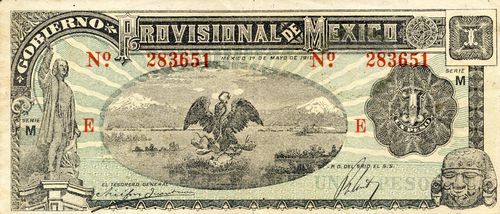

The scene of the so-called Tlaxcala Congress was replaced by the central vignette used in the issues of the Provisional Government of Mexico and Veracruz, that is, “the marble peaks of the legendary volcanoes, the diaphanous mirror of the lake of Cuauhtémoc and the symbolic queen of the air, preying on the filthy reptile’”Billetes Jarochos”, El Pueblo, 13 December 1914 as El Pueblo poetically described the legend of the foundation of Tenochtitlan and the rosette with the name moved to the right , while the date, signatures, decree and the Coyolxauhqui remained the same, the main ink was black and the backgrounds green-blue with fine lines and in part of the underprint the legend “UN PESO” microprinted in wavy form. On the back appears a 1908 silver peso with the Phrygian cap and the denomination “1” on the sides on two rosettes and in the four corners in a blue tone -although several shades are distinguished- and the seal of the Ministry of Finance in green. For this issue ten series from L to U are known, none of them with the imprint of the printing house at the bottom. Although the previous design“los billetes de uno y dos pesos, de la nueva emisión. Probablemente empezaran a circular desde la decena próxima, pues con ese fin, se trabaja activamente”, El Pueblo, 17 June 1916 was still reproduced in the press in mid-June, both versions would have reached circulation.
El Pueblo reported the printing of 300 thousand pesos a day“Serán lanzados a la circulación los nuevos billetes de uno y dos pesos”, El Pueblo, 15 June 1916 and praised the work, stating: “As regards quality and artistic finish, both in terms of drawing and engraving, it exceeds that of North American manufacture. The same paper is truly infalsificable.”idem.. Years later, comparing the engraving of the Aztec Calendar of the ABNC notes and the Government Printing Office, Fernando Fernández himself highlighted the nationalist character he had managed to get printed “El arte del grabado retrospectivo aplicado a los valores mexicanos constituye una novedad y honra al obrero nacional”, El Nacional, 19 January 1917. But not all shared this opinion: Charles Blackmore, resident representative of the ABNC, a few days after they were put into circulation, sent some copies to the headquarters in New York saying that the shops rejected them because of the bad quality of engraving and printing, and suggested looking for the Constitutionalist representative in that city to demonstrate the differences and get this contract Archives lntemational Auction XXXIII, 28 June 2016, lot 816.
In addition, cartones of 5, 10 and 20 centavos were also produced. Those of five centavos had the same design as previous ones, but instead of red they were orange, with a Roman five superimposed on the image of Justice; those of ten centavos of a more intense blue with a Roman ten on the obverse and those of 20 centavos were printed on lead colored paper, with the Piedra del Sol on the face and its value and the legend ‘Gobierno Provisional’ on the reverse“Seguirán circulando ros billetes de uno y dos pesos y la moneda fraccionaria”, El Pueblo, 30 April 1916. They all had a stylized security monogram with the letters GCM (Gobierno Constitucionalista de México).
I suppose that hoping that the small notes would be quickly ready, on 3 May 1916, Secretary Cabrera proposed to the Monetary Commission to modify the range of the denominations that made up the 500 million of the 3 April decree , increasing those of one peso to 100 million; those of two pesos to 80 million; those of five and ten pesos to 70 million, while decreasing those of 20, 50 and 100 pesos to 60 million each AGN, SC226 Comisión Monetaria, Caja 69, Libro de Actas No.1de la Comisión Monetaria, Acta #4 , 3 May 1916. Although there were no objections from the members, it seems that the suggestion was not presented to Carranza nor was the decree modified. To date, I have only been able to find a reference to the amount printed in Carranza’s report to the Congress on 15 April 1917, where it mentions 90 million, although this figure could include the fractional notes as well. Table 3 presents an estimate based on the numbers of the examples that I have been able to observe.
| Table 3: Estimated quantities produced by the Oficina Impresorabased on the serial numbers from various collections | ||||
| Denomination (pesos) | Estimated quantity | Numbers | Series | Face value $ |
| 1 highest number recorded 1227827 | 5,000,000 | 1-1500000 | J “provisional” | 5,000,000 |
| 1 | 50,000,000 | 1-5000000 | L-U | 50,000,000 |
| 2 | 10,000,000 | 1-5000000 | A-B “provisional” | 20,000,000 |
| 2highest number recorded 2955812 | 5,000,000 | 1-5000000 | Z | 10,000,000 |
| Total | 70,000,000 | 85,000,000 | ||
Security measures
The Revolution was a period in which there were intrigues and plots, so many of the communications, including several telegrams on the issue of paper money, were made in an encrypted manner and it seems that some of these peculiarities were introduced as security codes on the notes. The infalsificables printed by the ABNC seem to have the intention of forming the word “Mexico” with the letters of the series. If the models and finally printed banknotes are contrasted it is seen that it was requested to modify the series in that each denomination had a different letter: 100 pesos M, 50 pesos E, 20 pesos X, 10 pesos I, 5 pesos C. It is not known if at the time an additional denomination of two or one peso with the series O was considered to complete the word, although it was not considered in the first decree.
In the case of banknotes printed in Mexico, in addition to the serial letter, all have a second letter. Due to the reduced number of series issued from the notes of the so-called Tlaxcala Congress, I have not identified if there was an intention with those letters. However, the one peso notes with the vignette of the Tenochtitlán legend form the word “INDOMBLES” when the ten series that go from the letter L to the U are joined and read in reverse.
Entry and withdrawal from circulation
The decree of April 1916 ordered the Ministry of Finance to put the notes of the new issue in circulation on 1 May. As noted above, the notes printed by the ABNC had begun arriving in Mexico from December 1915 and according to El Pueblo the printing of the two lowest denominations began in March 1916“El Banco Nacional mejoró ayer el tipo abierto por la Comisión de Cambias y Moneda”, El Pueblo, 2 April 1916. Although at the beginning of April Carranza had instructed the Printing Office to concentrate on this issue“Se suspenderán en absoluto los trabajos de emisión del actual papel moneda. La Oficina Impresora de Estampillas, se concentrará a preparar lo relativo a la nueva emisión de billetes por valor de uno y dos pesos”, El Pueblo, 5 April 1916 only the ABNC notes went into circulation when paying public employees their salaries for the first ten days of May. Despite working flat out, the new one- and two-peso notes were not released until the beginning of June, forcing the authorities to announce, as a temporary and emergency measure, the acceptance of $1 and $2 notes of the Gobierno Provisional issue and the fractional currency at half its value, as long as they were for transactions for less than five pesos, “Seguirán circulando los billetes de uno y dos pesos y la moneda fraccionaria”, El Pueblo, 30 April 1916 generating great confusion.
Speculators, commonly known as coyotes, quickly appeared on the scene offering employees the chance to exchange their infalsificable for notes of the old issues that allowed them to make low value purchases, while they rushed to turn them into gold at the rate of 20 percent as established by the government. To avoid abuses the period for circulation of the three higher denominations was reduced to 30 June, while in the absence of new low-value notes, the old ones of 5 and 10 pesos circulated until 3 June, and the use of the 1 and 2 peso paper money was extended on three separate times until 31 January 1917. Bertha Ulloa, Moneda, Bancos y Deuda in Historia de la Revolución Mexicana, Vol. 6, p. 166. All this complicated the introduction of the infalsificable currency, since the first days there were no low denomination notes and then they were not enough, causing discomfort to the population, commerce and even the military commanders and local governments throughout the country, who asked Carranza to send them new notes and / or continue accepting those that should have stopped circulating.
Although the introduction would not officially be done by direct exchange, some references seem to indicate the opposite, such as a report on 15 June in Monterrey that said that the State Treasury and the Treasury Department were initiating the exchange of notes and cartones of the old issue for the new ones. “Notas de Monterrey: Quedó abierto el canje para toda clase de billetes y cartones de la vieja emisión”, El Pueblo, 21 June 1916. Meanwhile, the collecting and amortizing offices sorted the notes withdrawn from circulation and prepared them for incineration.
In spite of the decrees to force all transactions in this currency and the threats and sanctions of the Government, “Los billetes de uno y dos pesos no deben sufrir descuento”, El Pueblo, 7 November 1916 distrust grew and contrary to expectations, the monetary reserves did not grow but ran out, forcing the authorities to suspend conversion into gold.
This gave way to a rapid depreciation of the infalsificable currency. At the beginning of June, Carranza informed the governors of the states that the exchange rate between the infalsificable paper and the old issues was already 4 pesos of the old issues to one infalsificable, and on the thirteenth of that same month the rate had devalued to a ratio of 10 to one. CEHM, Fondo XXl-4, telegrams of Venustiano Carranza to governors of various states, 2 and 13 June 1916. Starting in October, the Ministry of Finance would set the rate weekly and by the end of the year it was less than half a centavo (table 4). This depreciation forced the government to demand from the states and from the population at large that the payment of duties and taxes be made in increasing proportions of gold, in silver or its equivalence in infalsificables at the rate of exchange defined by the Ministry of Finance.
Naturally the reaction was immediate and employees, laborers, and workers began to demand payment in metallic currency. In response, on instructions from Carranza the Ministry of Finance ordered that salaries and wages be paid at least 50 percent in silver and the rest in infalsificable at a rate of exchange defined by the Treasury, although the salaries of the federal employees would be met by a separate special provision that would be issued in a timely fashion. At the beginning of December federal employees were still paid 95% in infalsificable and 5% in coin, but as of 1 January 1917 troops stopped being paid in infalsificables.
The notes printed in Mexico had even worse luck. As Blackmore had pointed out, some merchants rejected them or took them at a discount. Greater confusion still generated the circulation of the two peso notes with and without the legend of “provisional circulation” mentioned above, which led the Treasury Secretary to have to clarify through the press and later through a circular that both were equally valid. El Pueblo, 15 October 1916 and circular 275 of the Ministry of Finance, 9 November 1916, stating that $2 notes with the legend “Circulación Provisional” across Serie A were legal tender.
On 2 December Carranza arranged that some contributions that were previously paid in infalsificable should be paid in part or in total in national gold, sealing the fate of this paper money. Immediately the circulation of metallic currency was re-established and its export allowed.
On 29 March 1917, the demonetization of these notes was decreed and, to remove them completely from circulation, a decree[text needed] was issued on 25 April, that from 1 May everything that carried import and export duties on the production of metals, would have a surcharge of one peso infalsificable for each peso or fraction in national gold, with which they would be withdrawn from circulation, and on 28 April circular 61 on deposits made in infalsificable in rent payments was issued[text needed]. At the beginning of September, in his report to Congress, Carranza stated that $20,110,669.45 had been incinerated and that the Comisión Monetaria had $219,762,484.62 more to incineratePeriódico Oficial, Tomo XLII, Núm. 75, 19 September 1917.
In January 1918 it was resolved that all the federal offices of Hacienda should regularly send their stocks of infalsificables to the Comisión Monetaria for it to be incinerated. Over $300,000,000 had already been retiredEl Pueblo, Año III, Núm. 1156, 11 January 1918. In the minutes of this Comisión Monetaria, in August 1918 almost 300 million pesos in infalsificables had been incinerated and as of 31 October 1919 the amount had grown to almost 363 million. Finally, in the report to Congress on 1 September 1920 De la Huerta said that there were still almost 107 million pesos in circulation.
Almost a million of infalsificables escaped being incinerated and appeared in Mexico’s treasury a century later https://backend.aprende.sep.gob.mx/media/uploads/proedit/resources/valores_de_la_nacio_e6d8a76d.pdf .
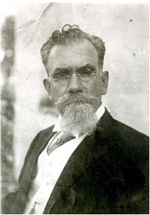 José Nicéforo Zambrano Cavazos was born in San Nicolás de los Garza, Nuevo León, on 22 February 1861. He joined the revolution during Madero’s campaign and at its triumph had been elected president of the Monterrey town council. He was imprisoned during Huerta’s regime but on release supported Carranza, both against Huerta and then against Villa.
José Nicéforo Zambrano Cavazos was born in San Nicolás de los Garza, Nuevo León, on 22 February 1861. He joined the revolution during Madero’s campaign and at its triumph had been elected president of the Monterrey town council. He was imprisoned during Huerta’s regime but on release supported Carranza, both against Huerta and then against Villa.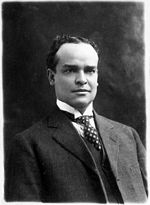 Rafael Nieto Compeán was born in Cerritos, San Luis Potosí, on 24 October 1883. As a young man he joined the Mexican Revolution and reached several important positions. He served as a federal deputy in 1912 to 1913 and constitutional deputy in 1916 to 1917. He was Oficial Mayor in 1914 and Undersecretary of Finance from 1914 to 1919. From 1920 to 1923 he was governor of San Luis Potosí and on 8 January 1923 was the first to grant women the right to vote (the decree was repealed in 1926). At the end of his career he was minister plenipotentiary of Mexico in Sweden (1923 – 1925) and Italy (1925 – 1926) and president of the company Ferrocarriles Nacionales de México.
Rafael Nieto Compeán was born in Cerritos, San Luis Potosí, on 24 October 1883. As a young man he joined the Mexican Revolution and reached several important positions. He served as a federal deputy in 1912 to 1913 and constitutional deputy in 1916 to 1917. He was Oficial Mayor in 1914 and Undersecretary of Finance from 1914 to 1919. From 1920 to 1923 he was governor of San Luis Potosí and on 8 January 1923 was the first to grant women the right to vote (the decree was repealed in 1926). At the end of his career he was minister plenipotentiary of Mexico in Sweden (1923 – 1925) and Italy (1925 – 1926) and president of the company Ferrocarriles Nacionales de México.